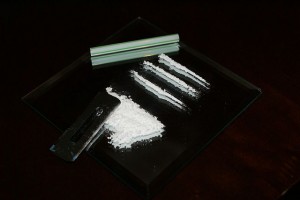How Crack Cocaine Widened the Black-White Education Gap
A new working paper (abstract; PDF) from William N. Evans, Timothy J. Moore, and Craig Garthwaite presents one explanation for the decline in black high-school graduation rates beginning in the 1980s:
We propose the rise of crack cocaine markets as an explanation for the end to the convergence in black-white educational outcomes beginning in the mid-1980s. After constructing a measure to date the arrival of crack markets in cities and states, we show large increases in murder and incarceration rates after these dates. Black high school graduation rates also decline, and we estimate that crack markets accounts for between 40 and 73 percent of the fall in black male high school graduation rates. We argue that the primary mechanism is reduced educational investments in response to decreased returns to schooling.
How did crack cocaine depress schooling returns? “Crack markets had three primary impacts on young black males: an increased probability of being murdered, an increased risk of incarceration, and a potential source of income,” explain the authors. “Each limits the benefits of education.” In other words, high school looks less attractive when you’re more likely to end up dead or in jail, or earn money.
This finding echoes a passage from Freakonomics:
While crack use was hardly a black-only phenomenon, it hit black neighborhoods much harder than most. The evidence can be seen by measuring the same indicators of societal progress cited above. After decades of decline, black infant mortality began to soar in the 1980s, as did the rate of low-birthweight babies and parent abandonment. The gap between black and white schoolchildren widened. The number of blacks sent to prison tripled. Crack was so dramatically destructive that if its effect is averaged for all black Americans, not just crack users and their families, you will see that the group’s postwar progress was not only stopped cold but was often knocked as much as ten years backward. Black Americans were hurt more by crack cocaine than by any other single cause since Jim Crow.
And then there was the crime.Within a five-year period, the homicide rate among young urban blacks quadrupled. Suddenly it was just as dangerous to live in parts of Chicago or St. Louis or Los Angeles as it was to live in Bogotá.*
* Sources include: Rebecca Blank, “An Overview of Social and Economic Trends By Race,” in America Becoming: Racial Trends and Their Consequences, ed. Neil J. Smelser, William Julius Wilson, and Faith Mitchell (Washington, D.C.: National Academy Press, 2001), pp. 21–40; Douglas V. Almond, Kenneth Y. Chay, and Michael Greenstone, “Civil Rights, the War on Poverty, and Black-White Convergence in Infant Mortality in Mississippi,” National Bureau of Economic Research working paper, 2003; Roland G. Fryer Jr., Paul Heaton, Steven D. Levitt, and Kevin Murphy, “The Impact of Crack Cocaine,” University of Chicago working paper, 2005.


Comments